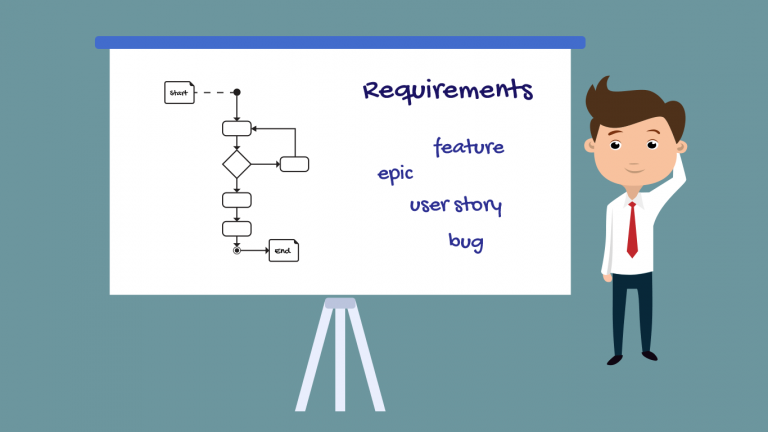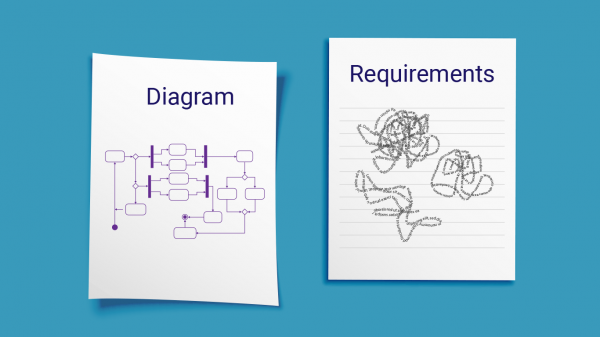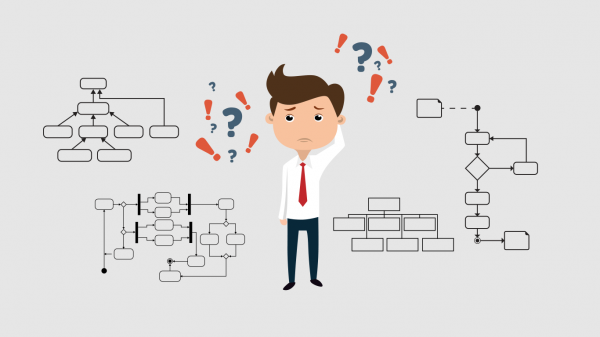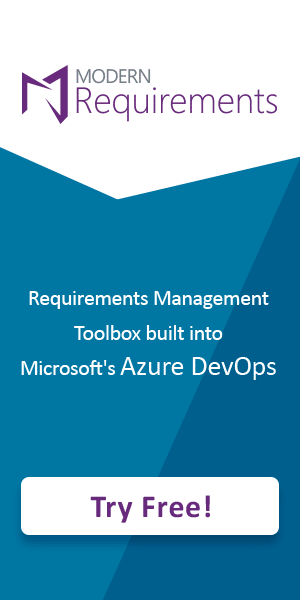The Benefits of a Built-In Diagram Tool for Azure DevOps
Process visualization has become an increasingly popular, beneficial, and effective approach for not only generating business workflows, but also for eliciting the needs of a working system. In this article, we cover the benefits of a built-in diagram tool for Azure DevOps.

Why is Building Requirements inside your Diagrams an Effective Approach?
We know that tools which create visual maps of activities have proven to be invaluable throughout the business world – a fact that has begun to ring true in the realm of requirements management as well. By including diagrams as part of the requirements process, users are easily creating a quickly-consumed, easy-to-understand, contextual view of their requirements.
TABLE OF CONTENTS
- Why Building Requirements Inside Your Diagrams Is An Effective Approach
- What’s Wrong With Creating Diagrams And Requirements Separately?
- How Does Modern Requirements4DevOps Solve These Issues?
- What Are The Benefits?
- Automation Too Easy To Ignore
- What Else Could Building A Diagram In Azure DevOps Offer?
- Collaboration
- Communication
- Efficiency
Many organizations, however, still follow the traditional approach to process visualization by unnecessarily creating diagrams separately from their requirements documentation.
By unifying these processes within a single tool, the Modern Requirements4DevOps Diagram tool allows you to seamlessly create diagrams and requirements in one easy-to-use interface, directly built into Microsoft Azure DevOps.
What's Wrong with Using Separate Requirements and Diagram Tools?
Diagrams and requirements are traditionally separate documents.
This causes a workflow wherein diagrams are used first to elicit requirements, followed by documents which are then used to report those elicited requirements, which are then often transcribed into requirements management tool.
It is a fully detached workflow, spanning multiple applications unnecessarily.
With multiple applications, users are often tasked with mastering each of these applications, or designating a master of these applications, and then must worry about integration issues that might arise down the road.
Can my Diagrams be exported?
Can they be saved in a format I can attach to my requirements?
How do I connect these diagrams to my requirements?
Where will they be stored so I can add them in my reports?
Who will manage these?
Who will keep the requirements and diagrams in sync?
The complications of a multiple application system are what drove us to create all of the capabilities of Modern Requirements4DevOps under the single integrated application model.
How Does Modern Requirements Diagram Tool Solve These Issues?

With all of the creature comforts of a traditional diagram tool, our Diagram capability allows you to easily create all of the diagrams you’ve seen in the past. But the added features of our diagramming tool make it impossible to confuse with tools of the traditional persuasion.
But how?
Our Diagram capability allows you to easily create diagrams that help you to both identify and create requirements directly within your diagrams. In other words, you can now build your diagrams and add in Azure DevOps work items/requirements directly into the diagram itself!
This presents a single workflow in which diagrams are used to manage, create, link, and identify requirements that are stored directly as work Items in Azure DevOps – all within the same application.
No more need to manage where a Diagram is stored, who will manage it, or whether or not the Diagram is fully up to date.
Diagrams are created directly within your Azure DevOps project and are always up to date, accessible and ready to work for you.
What Are The Benefits?
Our Diagram module has always had one goal.
Make work less tedious, and help you put the analysis back in Business Analyst.
We know that traditional, separated diagram content can cause several headaches.
As diagrams are created, they must be stored so that they are easily accessible. They must then be found, changed, updated and resubmitted whenever requirements change.
Once changed, reports need to be created, or updated, and the whole process can be a tedious logistical hassle that takes more time than it should.
With the Modern Requirements4DevOps Diagram module, changes are simple to make, and don’t come with the traditional logistical nightmares.
Trust us.
We also create Diagrams.
If changes are necessary you can simply redraw your Diagram, save a Diagram template for easy rebuilding and reuse if necessary, and easily manage or change your attached requirements directly from the Diagram module.
With Modern Requirements4DevOps you also don’t need to worry about reflecting your changes back in your TFS/VSTS/Azure DevOps instance. All of the changes made in our modules change your Azure DevOps requirements immediately.
No more need for those painfully long transcription sessions we’ve all grown to hate.
By building a diagramming tool that grants you full control of your requirements, Modern Requirements is able to offer you the award-winning capabilities that help you steer away from the tedious and get back to the analysis.
Automation Too Easy To Ignore
Our Diagram module has two sets of capabilities, each with their own powerful functions.
Our first capability helps you build your diagrams with stencils, a robust positioning and style guide, and allows you to add requirements directly onto your diagrams.
This is where you start.
Using pre-built templates and drag-and-drop stencils you can easily create all of the various types of diagrams you would like to have.
But then what?
You can create links, manage relationships between work items and diagram nodes… but should you?
Our expert trainers typically say no.
Once a Diagram is built, a user is ready to exploit the automation features of the Diagrams’ modules Analysis capability.
In this area your Integration Stories (think User Stories, Product Backlog Items, Requirements…), Use Cases, and Test Cases are all automatically generated based on the Diagram you just created.
By analyzing the pathways through your diagram, requirements are generated that require you to simply provide a name and publish. Once published your new requirements are created directly into the Azure DevOps repository and can be found in your backlog with the diagram image placed both as an attachment, and as part of that requirement’s description.
Using the automation features allows you to elicit higher level requirements with the simple push of a button. By creating all of the high-level content it is simple for you to ‘touch up’ your requirements by then adding finer detailed requirements to your Diagram in back in the Diagram tab.
The automation provided by our Analysis tab removes the tedious endeavor of handcrafting contextually complex, high level requirements.
With the image of the diagram for context, and the link back to the diagram in the Work Item’s link tab, a requirement built in our Diagram module keeps all of the context of the Diagram itself. This added context allows both developers and QA members to create tasks, bugs, and tests for that individual requirement easier and more effectively.
What Else Could Building A Diagram In Azure DevOps Offer?

Here at Modern Requirements we have developed the Diagram module to put aside the issues of traditional diagramming methods.
And, by being built directly into Azure DevOps our Diagram module has been found to benefit users in many different ways.
Microsoft’s Azure DevOps is a platform that is built to foster collaboration, communication, and efficiency. These are all properties that we have done our best to emulate and implement.
Collaboration
In our Diagram tool alone, we provide two unique ways to collaborate on a Diagram and its content.
The first is the ability to provide notes on any individual node of a diagram. This allows you to add instructions or information to other users that is highly visible when changing a node.
The second is the ability to use our built-in discussion section to easily comment, or provide information on, the diagram as a whole.
By providing the option to have detail-oriented conversations separately from the general discussion, you can be sure that your collaboration on the smaller details never gets lost in the discussion.
Communication
With Modern Requirements4DevOps your discussion can be both in the right place, with the right people, and can easily be kept on topic with the built-in chat controls.
By using the @ prefix, you can easily notify team members that they should be part of the discussion.
To help keep the discussion on topic you can use the # prefix which allows you to reference specific a work item.
By using the built in ‘Follow’ feature in Azure DevOps, you can even follow your Diagram and be notified of any changes that are made that are not yours.
Efficiency
Built directly into Microsoft’s industry leading Azure DevOps, Modern Requirements4DevOps offers teams the opportunity to be more efficient than ever before.
By creating both requirements and diagrams within this platform your team benefits from a single source of truth. Requirements that are authored and engineered from the Diagram module are easily accessible to your team immediately. No need to track down, transcribe, and manage where requirements are.
Our Diagram capability gives your team the power to drive towards the most efficient practices yet.
Time to Read: 10 minutes
Related Articles
Request a Demo!
- Schedule a demo with one of our trained product experts.
- Receive a personalized demo that mimics your team's process
- Engage our experts on topics such as workflow or best practices.

Reduce UAT Efforts
50% Reduction in UAT efforts

Proven Time Saving
80% time saving on creating Trace Analysis

Streamline Approvals
Significant reduction in approval delays

Increase Performance
50% requirements productivity improvement

Reduce Rework
10-fold reduction in development rework

Simplify Compliance
40% reduction in compliance reporting efforts


